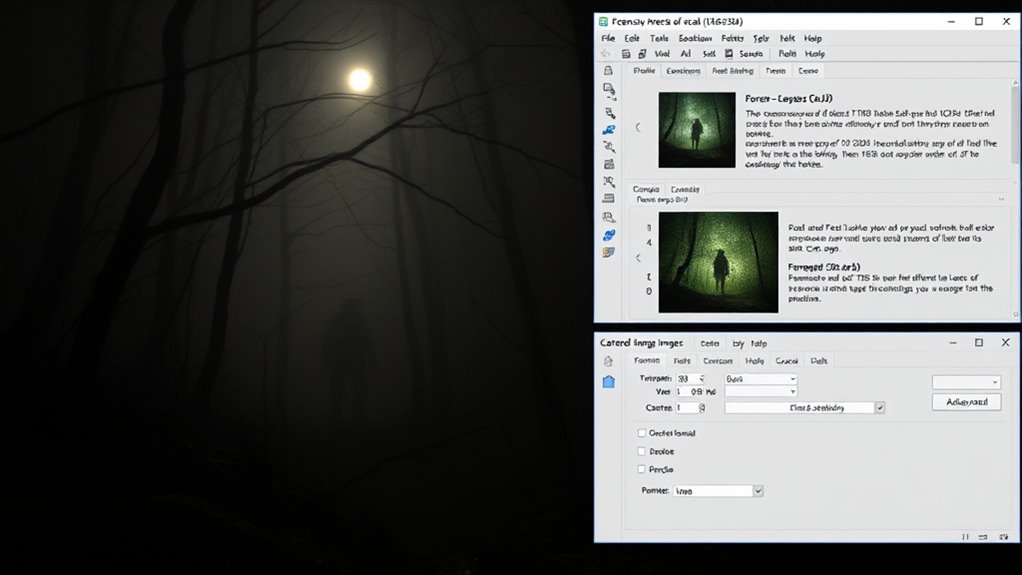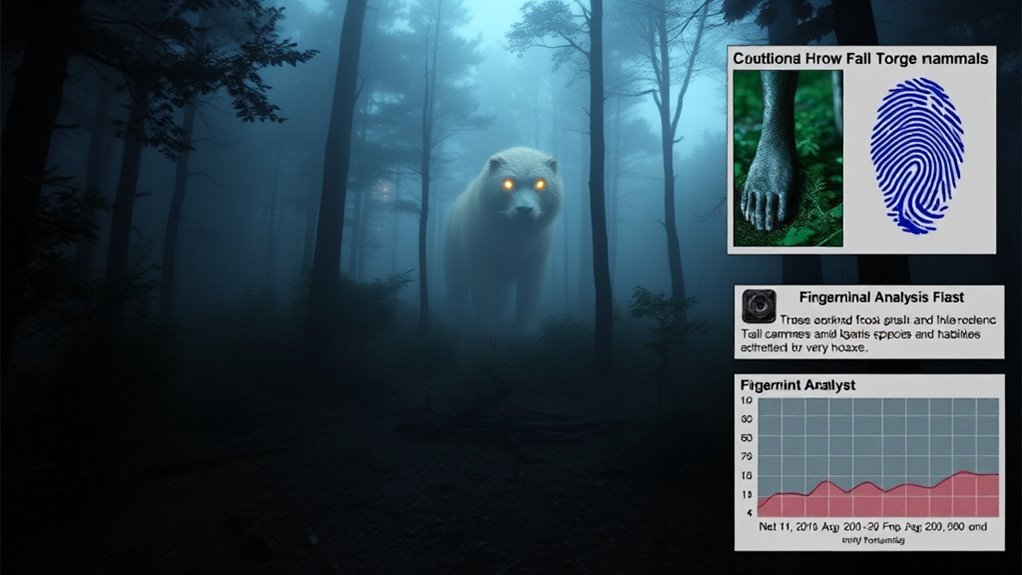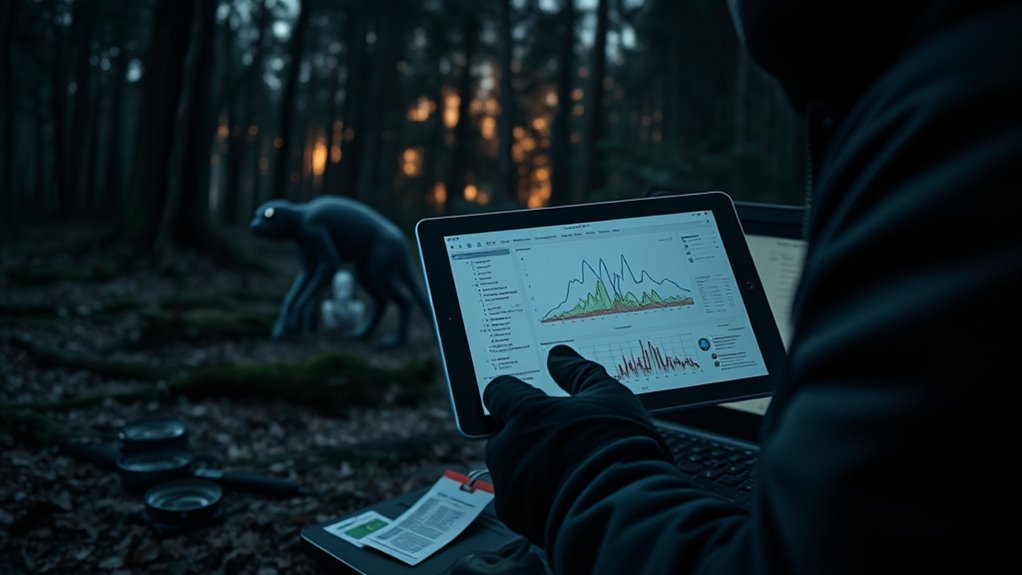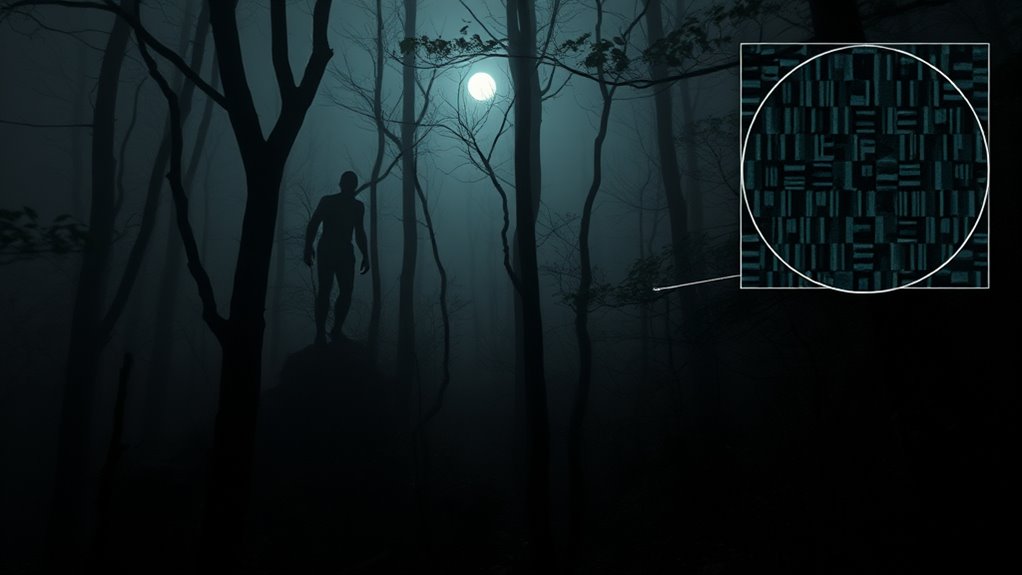To separate hoax photos from genuine cryptid evidence, you should analyze metadata and digital footprints for signs of manipulation or tampering. Examine image consistency, shadows, and proportions to spot anomalies or unnatural textures. Use forensic tools to verify image integrity and cross-reference features with known species and habitats. Investigate the source’s credibility and context for motives or bias. Continuing with this approach reveals even more sophisticated techniques to uncover the truth behind cryptid photos.
Key Takeaways
- Analyze metadata, digital signatures, and compression artifacts to detect signs of tampering or digital manipulation.
- Examine inconsistencies such as mismatched shadows, unnatural textures, or irregular proportions indicating potential hoaxes.
- Cross-reference the image with known authentic photos and assess environmental or contextual plausibility.
- Utilize expert forensic tools and peer reviews to identify subtle edits or digital alterations invisible to casual inspection.
- Evaluate source credibility, eyewitness reliability, and behavioral consistency to distinguish genuine evidence from fabricated images.
Analyzing Photo Metadata and Digital Footprints

When examining photo metadata and digital footprints, you can uncover essential clues about a picture’s authenticity. Analyzing digital signatures helps verify if the image has been altered or if it originates from a credible source. By examining metadata, you can identify details like creation dates, device information, and editing history, which can reveal inconsistencies. Assessing image compression is also crucial; excessive compression may indicate manipulation or attempts to conceal editing. If the image shows signs of heavy compression, it might be a sign that details have been erased or altered. These digital footprints serve as vital indicators, helping you determine whether the photo is genuine or potentially fabricated. Paying close attention to metadata and compression details can safeguard your evaluation process from deception.
Examining Image Consistency and Anomalies

Examining image consistency and anomalies is essential for identifying potential hoaxes or genuine cryptid evidence. By understanding the historical context, you can recognize patterns or techniques used in past hoaxes, helping you spot similar tactics today. Cultural influences also shape how images are produced and perceived; certain symbols, styles, or mythic themes may reveal cultural motivations behind a photograph. Look for inconsistencies like mismatched shadows, irregular proportions, or unnatural textures that don’t align with the scene’s context. These anomalies often indicate manipulation or fabrication. Comparing the image with known authentic photos and considering cultural or historical factors can help you assess whether the image is credible or suspicious. Your keen eye for such details is indispensable in separating genuine cryptid evidence from hoax images.
Utilizing Forensic Software for Image Verification

Utilizing forensic software for image verification allows you to uncover subtle signs of manipulation that may not be visible to the naked eye. Deepfake detection tools help identify inconsistencies in pixel patterns, lighting, and facial movements, revealing synthetic or altered images. Watermark analysis is also essential; examining embedded or missing watermarks can indicate tampering or forgery. These software tools analyze metadata, compression artifacts, and other digital footprints that reveal manipulation. By systematically applying these techniques, you can distinguish genuine cryptid photos from hoaxes more effectively. Forensic software offers precise, objective evidence that supports your assessment, reducing reliance on subjective judgment. When combined with other forensic tactics, it becomes a powerful approach to verifying the authenticity of cryptid images.
Cross-Referencing With Known Species and Environments

You should compare the creature in the photo to known species using matching techniques to identify similarities. Checking habitat consistency helps verify if the environment matches where such a species naturally occurs. These steps can quickly reveal whether the evidence aligns with genuine cryptid sightings or is likely a hoax.
Species Matching Techniques
Cross-referencing suspect images with known species and their typical environments is a crucial step in forensic analysis of cryptid claims. Focus on scale patterns to identify inconsistencies; genuine animals usually have specific, recognizable arrangements. Examine movement cues as well—how the creature moves can reveal whether it matches known species’ behavior or if it’s artificially fabricated. Look for details like limb articulation, gait, or fluidity of motion, which are difficult to fake convincingly. Comparing these elements with documented behaviors and physical features helps you spot hoaxes or misidentifications. If the scale patterns don’t align with a known species or the movement cues seem unnatural or exaggerated, it raises suspicion. This technique sharpens your ability to distinguish authentic cryptid evidence from manipulated or staged images.
Habitat Consistency Checks
Habitat consistency checks involve comparing the environment depicted in a cryptid image with the known habitats of similar species to identify discrepancies. You examine whether the location aligns with the known geographical distribution of related animals, considering factors like climate, terrain, and ecological impact. If an image shows a creature in a habitat inconsistent with its supposed species’ range, it raises suspicion. For example, a cryptid claimed to live in dense forests should not appear in arid deserts or high-altitude regions unless there’s evidence of ecological adaptability. Cross-referencing known environments helps verify authenticity by ensuring the habitat matches the species’ ecological impact and geographical distribution. Discrepancies often indicate hoaxes or misrepresentations, making habitat consistency a crucial forensic check.
Investigating Source Credibility and Context

You need to assess how trustworthy the photo source is before drawing conclusions. Using contextual analysis techniques helps you understand the circumstances surrounding the image, while cross-verification methods confirm its authenticity. By carefully evaluating source reliability and context, you can better distinguish genuine cryptid evidence from hoaxes.
Source Reliability Assessment
Evaluating the credibility of a source is essential when distinguishing genuine cryptid evidence from hoaxes. Begin with historical document analysis to verify the origin and authenticity of reports or images. Check for consistency over time and cross-reference with other credible sources. Eyewitness testimony evaluation is also fundamental; consider the witness’s background, potential biases, and the conditions under which they reported sightings. Look for signs of embellishment or inconsistency that may indicate fabrication. Avoid relying solely on a single account; instead, seek corroboration from multiple, independent sources. This rigorous assessment helps you determine whether the evidence is likely genuine or manipulated, ensuring that your conclusions are based on reliable, well-vetted information.
Contextual Analysis Techniques
To accurately assess the credibility of cryptid evidence, it’s essential to analyze the context surrounding each source. Consider photographic ethics—whether the image was manipulated or staged—and how cultural symbolism might influence its interpretation. Understanding the origin of the photo helps reveal motives or potential biases that shape its presentation. Cultural symbolism can also color how images are perceived; for example, certain symbols or settings may be intentionally included to evoke specific beliefs or emotions. By examining these factors, you gain insight into the authenticity of the evidence beyond surface-level analysis. Contextual analysis helps differentiate genuine cryptid sightings from hoaxes rooted in cultural narratives or ethical lapses in photography, strengthening your overall assessment.
Cross-Verification Methods
Cross-verification involves scrutinizing the credibility of sources and the context in which cryptid evidence appears. You need to assess whether psychological deception influences the presentation or interpretation of the evidence, as hoaxes often exploit biases or mislead viewers. Consider cultural influences that shape how cryptids are perceived or reported; understanding local legends, folklore, and societal beliefs helps distinguish genuine sightings from fabricated claims. Verify the source’s history and motives—are they known for hoaxes or credible investigations? Cross-referencing multiple independent reports and analyzing the consistency of details can reveal patterns indicative of authenticity or deception. By critically examining source credibility and context, you minimize the risk of falling for psychological deception and better identify genuine cryptid evidence.
Applying Expert Analysis and Peer Review

Expert analysis and peer review are essential steps in distinguishing authentic cryptid evidence from hoaxes. You rely on specialists to evaluate the evidence objectively, often using artificial intelligence tools to detect subtle manipulations. Expert consensus helps validate findings and weed out false positives. During peer review, multiple experts scrutinize the evidence, ensuring rigorous standards are met.
| Step | Purpose |
|---|---|
| Expert Analysis | Detects signs of digital tampering or artificial edits |
| Peer Review | Confirms findings through multiple independent assessments |
| Artificial Intelligence | Assists in identifying inconsistencies and deepfakes |
This process ensures that only credible evidence contributes to cryptid research, reducing the influence of hoaxes.
Frequently Asked Questions
How Can Deepfake Technology Impact Cryptid Photo Authenticity?
Deepfake technology can seriously challenge your ability to verify cryptid photos’ authenticity. As deepfake detection improves, you’ll need to stay alert for manipulated images that look convincing but are false. This tech complicates distinguishing genuine cryptid evidence from hoaxes, making image authenticity harder to assess. To counter this, focus on forensic analysis methods that identify inconsistencies and artifacts, helping you separate real evidence from sophisticated digital fabrications.
What Role Do Eyewitness Testimonies Play in Validating Images?
You rely on eyewitness testimonies to validate cryptid images, but their credibility matters. Strong eyewitness accounts often enhance image authenticity, especially when testimonial consistency is confirmed over time. You should evaluate whether the witness is reliable and if their story remains consistent across different recountings. While valuable, testimonies alone aren’t foolproof; combining them with forensic analysis helps you better distinguish genuine cryptid evidence from hoaxes.
Can AI Detect Subtle Manipulations in Cryptid Photographs?
Like Sherlock Holmes unraveling a mystery, you wonder if AI can spot subtle manipulations in cryptid photographs. Using advanced photo forensics, AI analyzes details that humans might miss, evaluating image authenticity with precision. It detects inconsistencies, shadows, or pixel anomalies, helping distinguish genuine evidence from hoaxes. With this technology, you gain a powerful tool to validate cryptid images, moving closer to uncovering the truth behind elusive creatures.
How Does Cultural Bias Influence Photo Interpretation?
You should consider how cultural perceptions shape your interpretation of cryptid photos, making it easier to see what confirms your beliefs and dismiss what doesn’t. Media influence often reinforces these biases, leading you to accept certain images as real or hoax based on popular narratives. Being aware of this bias helps you analyze photos more objectively, focusing on evidence rather than cultural stereotypes or media-driven expectations.
Are There Legal Considerations in Sharing Suspicious Cryptid Images?
Did you know over 60% of people share suspicious images online without considering legal ramifications? When you share cryptid images, legal ramifications and privacy concerns come into play, especially if the photo invades someone’s privacy or is part of a hoax. You must be cautious, as sharing misleading or unverified images could lead to legal trouble, damage reputations, or violate privacy laws, putting you at risk of serious consequences.
Conclusion
By mastering these forensic tactics, you become a detective in the epic quest for truth, slicing through hoaxes like a hot knife through butter. Your keen eye and thorough analysis can reveal the tiniest inconsistencies hiding in plain sight, turning the tide against false cryptid claims. Remember, in this world of shadows and illusions, your diligence is the ultimate weapon—because uncovering reality is the most vital puzzle you’ll ever solve.









